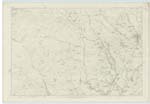OS1/3/20/61
| List of names as written | Various modes of spelling | Authorities for spelling | Situation | Description remarks |
|---|---|---|---|---|
| CARWINNING HILL | Caerwinning Hill Caerwinning Hill Caerwinning Hill Carwinning Hill Carwinning Hill Carwinning Hill Carwinning Hill Caerwinning Hill |
William Patrick Waterside Robert Craig Ryesholm John Montgomery Dalry Parish Map Full. [Fullertons] Gazetteer Johnston's Co. [County] Map Capt. [Captain] Blair of Blair New Stat. Acct. [Statistical Account] |
007 | A hill of considerable elevation, on which are the remains of an ancient Fort, described in the Stat. Acct. [Statistical Account] of the Parish, as having been formed of 3 concentric walls of stone, the greater part of the materials of which were removed to make fences. In the Acct. [Account] there is mention made of the vestiges of a Fosse being visible at the foot of the hill, but I have seen nothing, that I can take upon myself to say, are vestiges of a Fosse. I have made every enquiry at several persons, but could not obtain any information concerning it. |
| FORT (Remains of) [Carwinning Hill] | 007 | Relative to the fort, Mr. Paton of Swinlees, has pointed out the remains of the walls which are marked on the plan as far as they can now be traced, he says that he got part of the stones removed which formed the walls of the fort; but that most of the stones were removed before his time. |
Continued entries/extra info
[Page] 61Dalry
CAERwinning Hill - New Stat Acct. [New Statistical Account]
This throughout Scotland, when found as the first syllable
of the names of places, is invariably spelled Car -
see Carberry Tower near Edinburgh, Carbrook, Cardross
Car - when found as the first syllable
of the names of places, seems to
signify, fortified. as Carstairs
Carlisle etc.
Jamieson
On the Summit of Caerwinning hill are the remains
of an ancient fortification. It appears to have formed
of three concentric circles or walls of stone, inclosing a space of 2 acres. The greater part
of the materials of which it was composed have been removed to build fences, &c
The outer wall cannot now be easily traced , but from what remains, it appears to
have been from 10 to 12 feet in thickness. The entrance has been on the western side.
It must have been a place of great strength, and commands a view of the
surrounding Country for many miles. The stones must have been brought from
a considerable distance, being as species tuffaceous trap, while the hill
itself is composed of felspar porphyry. It is believed that the Scottish army
were encamped in this fortification previous to the Battle of Largs.
New Stat. Acct. [Statistical Account]
Transcribers who have contributed to this page.
Chr1smac -Moderator, DANIALSAN
Location information for this page.
Linked mapsheets.




